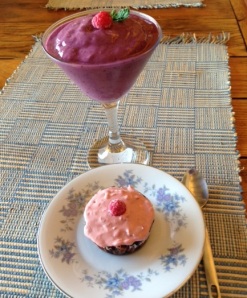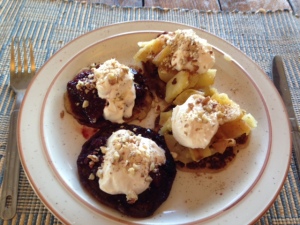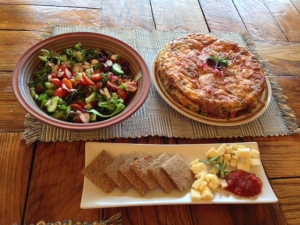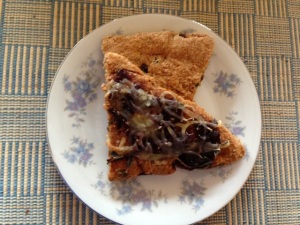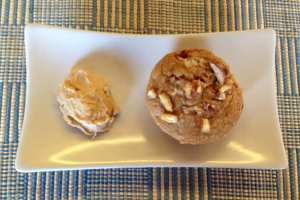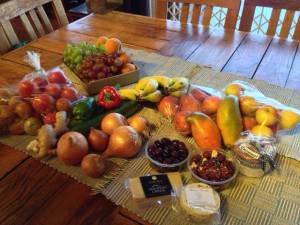I once ate at a restaurant that changed the way I thought about food, and ultimately changed my life. I am going to write more about this restaurant in upcoming posts, but in this one I just want to talk about what they taught me about portion control.
You can’t read an article on dieting without encountering tips on how to eat less – everything from weighing your food, counting calories, dividing up your plate by food group, eating from a smaller plate, waiting 20 minutes before having seconds. It goes on and on. All great advice, some of which works for me and some does not. When it comes to appetite regulation I will try anything once, and keep doing anything that helps. These are the “Hunger Games” and I need any possible advantage to tip the odds in my favor! Of course if the hormones that regulate appetite are working correctly, you know intuitively how much to eat. But with our western, fast food life style, this precise and beautiful control mechanism has been disrupted for many of us.
I just read an article this morning about how parents still try to coerce their kids into eating all the food on their plate. In a world where portions size is out of control, this may not be the best life skill. Depending on who is dishing up for you, the food on your plate is not the best guide to how much you should eat!
My whole strategy is about eating more in order to eat (and weigh) less:
- Eat more vegetables and fruit.
- Eat more for breakfast.
- Eat more delicious real food.
- Eat more proper meals.
- Eat more nutrient dense foods with a high fiber and water content.
- Eat a greater variety of food.
- Eat more healthy fats and proteins.
Without trying too hard this results in eating less. You will find that you:
- Eat fewer calories overall.
- Eat little to no junk or processed food.
- Eat no “empty calories”
- Don’t succumb to out-of-control binge eating.
- Eat fewer snacks.
- Eat less carbohydrates in favor of a more balanced ratio of fat, carbohydrate and protein.
This post is about how my favorite restaurant taught me about eating more courses in order to eat less! I have eaten many multi-course meals at restaurants in my life, some excellent, some not so good. I once paid a fortune for a meal at a fancy restaurant where each course was one or two tablespoons of food at the most. It was utterly delicious but I came away famished and feeling very ripped off! I have had a lot more 3 course meals where each individual course is enough for 2 and I stumble out in a food coma with a rather sore tummy vowing “never again!”
And then there was that life changing meal at Tokara after which food would never be the same again. I know they teach chefs about portion control in culinary school. But like all students, some apply what they learn in real life and some do not. Richard Carstens, the Tokara chef, gets it exactly right in my opinion. His plates are designed so that you can eat a starter, a main course and a dessert and come away comfortably full but not stuffed. Dinner even includes an amuse-bouche and intermezzo, which add to the experience without adding to the calorie count 🙂 This is my experience every time and I have checked in with friends and family who have gone there on my recommendation and they report the same. I know that there are many excellent chefs and good restaurants around the world that are getting this aspect of food preparation right, but this was the first time I experienced it quite so magnificently.
Here we come to that “small plate” dieting advice and why I don’t care for it. The theory is that you will fill your plate regardless of size, so by using a smaller plate you end up eating less. However, like most fine dining restaurants, at Tokara you get what a friend of mine calls “a lot of plate:” A big plate, with a modest amount of food. This can be taken as a symbol of pretentious, over-priced food, but it doesn’t have to be. I would describe the Tokara portions as generous, without being ridiculous. The food is as visually appealing as it is delicious and the big plate is the canvas upon which a work of art is created. It is not a “feeding trough” to binge over.
Reflecting on this approach to eating, I began to compare it with how I eat at home. The meals I grew up with were buffet-style. There would be a number of dishes on the table, each person would dish up for themselves and then decide whether or not to have seconds (or thirds!). If you arrive at the meal as a hungry fat person you tend to pile your plate and eat too fast. You have already eaten more than enough but fail to realize this, and reach for “seconds”. Seconds usually consist of cherry picking the foods on the table you find the most appetizing, and for me this usually meant the starch (potatoes, omg, potatoes!). You then sit back and debate whether you have “room for dessert.” I will give you a clue – I always had room! Ice cream slides in beautifully to all the little spaces in your tummy left by the other food.
While eating multiple courses in a restaurant is normal, I would never have thought to eat this way at home. Unless I was hosting a dinner party. And I never host dinner parties. But then I thought why not? Cooking really opens your mind to changing your eating behavior. It turns out it is no more effort than cooking buffet-style and a lot more satisfying! Eating this way has portion control built right in. As often as possible I have lunch or dinner that involves a starter, a main course and a dessert. Yes dessert. I am good at desserts and have a fruit-based, sugar-free, high-fiber dessert about 3 or 4 times a week. People who think I am “on diet” are horrified and think I have lost the plot. If the dessert is highly nutritious, doesn’t have sugar, refined flour or excessive fat, what’s the problem? I guess you may ask – does a dessert that meets all those criteria qualify as dessert? Come to my house and we can discuss over chocolate raspberry cupcakes 🙂
What I like about this approach is that it primes you to move from one stage of the meal to the next, and end when the meal is over. Start with soup or salad, progress to a main course consisting of a protein and plenty of fresh vegetables, and end with a dessert as described above. You can even indulge in a coffee and block of dark chocolate at the end to really finish on a high note. Notice how vegetable-heavy this meal is? There is always a single, appropriately sized portion of protein and the fat content comes along as part of the food preparation (eg: coconut oil for sautéing veggies or in the dessert) or adds flavor in the form of a few nuts, a sprinkling of grated cheese or a dab of good butter. I make the starch component optional. Some of my meals include a slice of homemade bread, a small portion of quinoa or some buckwheat pasta. The starch no longer dominates the meal if it even shows up at all.
The part of my brain that runs my appetite goes along with this approach beautifully. As much as I adore the soup, I don’t go for seconds, because the main course awaits. Because I know what’s for dessert, cause “I dun made it myself,” I am happy to move on from mains without “seconds.” And then the magic happens. The meal is over and I am full. The courses force me to pace myself and by the time the dessert is done, the starter has made its way through my digestive track to whatever bit it needs to get to trigger the “satiety signal.” I have a little moment of panic because it all seems so indulgent and over the top and so I do a little mental review of what I ate, realize it was mostly vegetables and that I am probably ok. I am done with food until the next meal.
Using this approach I don’t have to throw out my nice big dinner plates and buy new tiny plates. But I don’t pile my plates either. I like to see a lot of white space and pretty garnishes on my plate along with a sensible portion of food. As a cook I find the experience very satisfying because I get to experiment with different styles of cooking and baking. I also comfort myself with the thought that if one thing flops we can just turn it into a 2 course meal and no one will feel too deprived!
So that’s my tip for the day for learning portion control: Eat at a great restaurant with an amazing chef if and when you can afford it, or experiment with making multi-course meals at home. Go heavy on the vegetables and light on everything else and enjoy!
